The Counterintuitive Wisdom from Niraamaya
Why Avoiding Discomfort Magnifies It and Appreciative Joy Transforms It
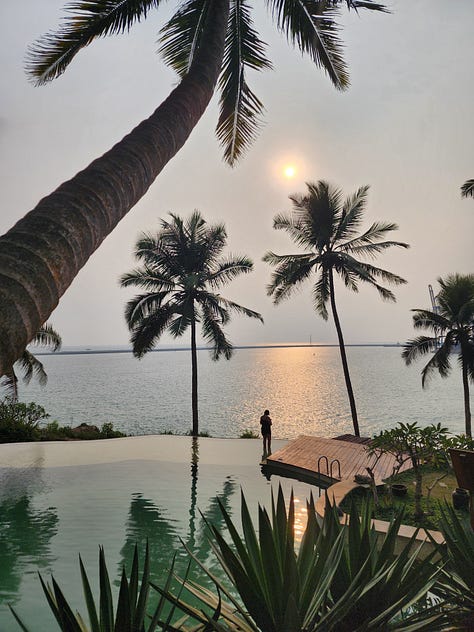
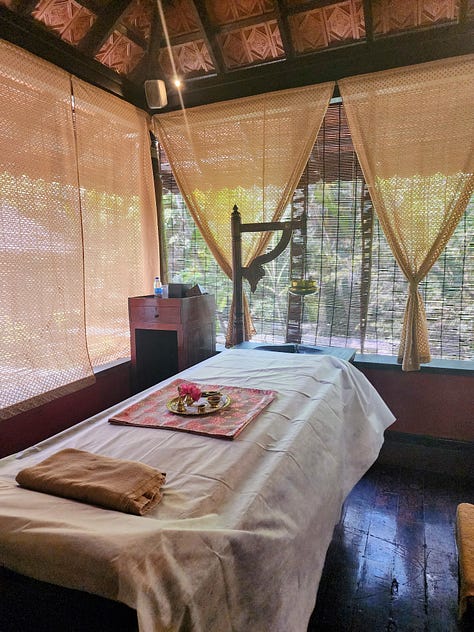
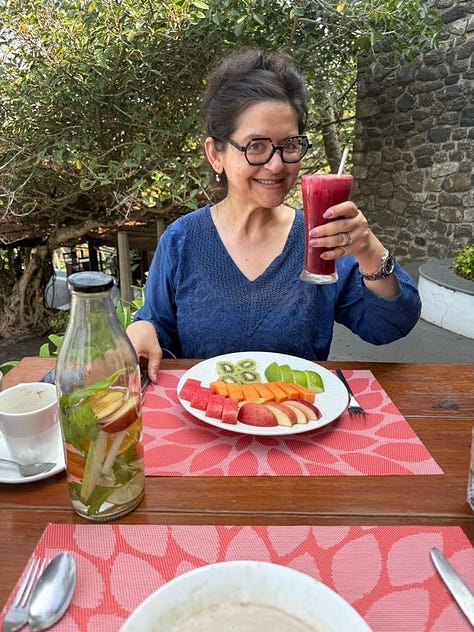




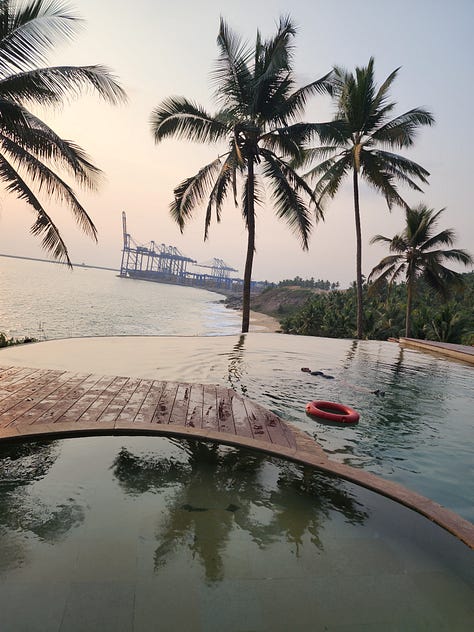
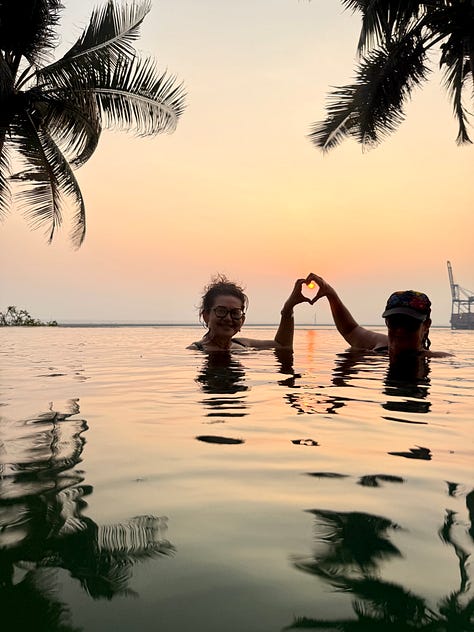
When was the last time you missed out on extraordinary beauty, connection, or opportunity because you couldn't look past a single flaw?
At Niraamaya, a luxury wellness retreat in Kerala, I witnessed firsthand our human tendency to fixate on what disturbs us while overlooking the abundant beauty all around. This experience revealed how our habitual avoidance of discomfort actually magnifies it, and how a simple mental shift toward appreciative joy could transform the entire experience.
A Sanctuary of Ancient Wisdom and Natural Beauty
As I settled onto my yoga mat at Niraamaya Resort in Kerala, the morning sunlight filtering through swaying coconut trees, I encountered a perfect opportunity to confront one of the mind's most powerful tendencies: our deeply wired negativity bias.
The resort itself is a testament to authentic Kerala architecture—30 cottages nestled among centuries-old banyan trees, their sprawling roots and branches creating natural canopies. The structures honor local traditions in extraordinary detail: ornate doors with intricate hand-carvings tell stories of the region's history; terracotta roofs keep the cottages cool; and magnificent wooden pillars stand as testaments to ancient skills. Most remarkably, these architectural elements have all been reassembled the way master craftsmen have created homes for centuries – without a single nail.
Inside the Ayurvedic center, practitioners whose knowledge has been handed down through families for decades work with reverent concentration. Their hands move with the certainty that comes only from thousands of hours of practice. The treatments aren't merely services but ceremonies—rituals of healing that connect to ancient wisdom.
The private beach offers a serene escape where the rhythmic sound of waves creates a natural soundtrack for contemplation. Few wellness experiences can rival yoga practice at sunrise with the vast Arabian Sea stretching before you.



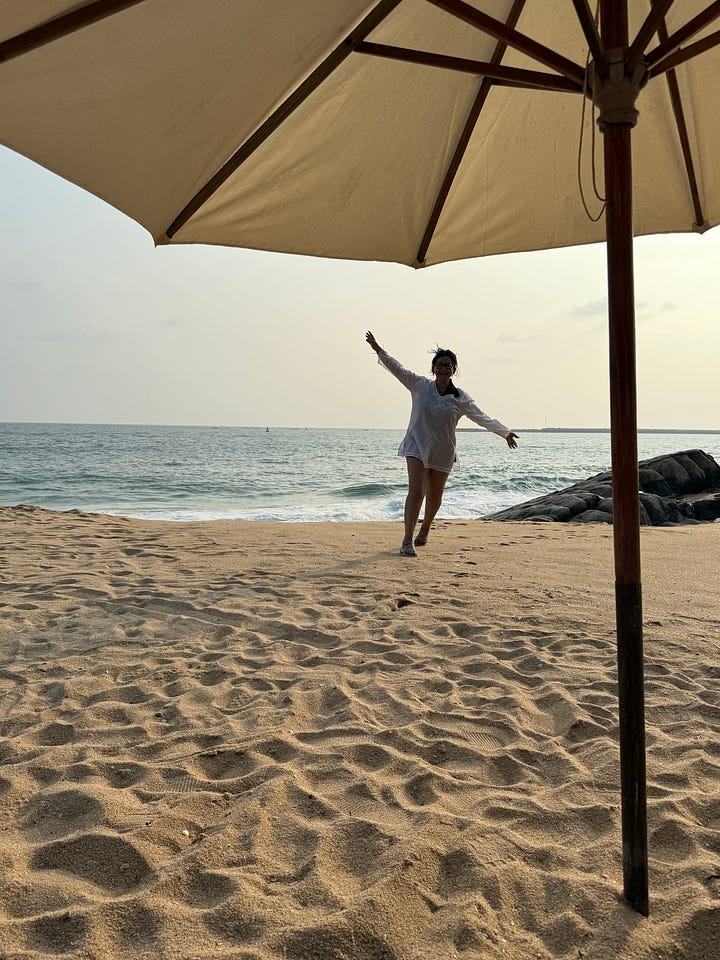
The Single "Flaw" in Paradise
And yet, as I settled into my morning yoga practice by this idyllic shore, I found myself witnessing an unexpected element in this healing landscape.
To my left, I could see a line of more than 30 fishermen pulling nets from the sea in perfect synchrony, their voices rising and falling in work songs that have accompanied this labor for centuries. Their movements—bend, pull, step back, repeat—created a visual rhythm that supports the mindfulness practice.
Behind our yoga instructor stood something entirely different: the massive infrastructure of a modern transshipment terminal. Occasionally, the deep, resonant horn of a container ship would sound across the water, announcing arrivals and departures in a global network of commerce.

I noticed several people in our yoga session shifting uncomfortably at these sounds, exchanging glances when the ship's horn bellowed across the water. I recalled a few online reviews I'd read before arriving—one particularly blunt assessment had declared that "Sadly the view from the hotel has been completely spoilt" by the port's presence.
I found myself distracted not so much by the sounds themselves, but by others' reactions to them and by the expectations those reviews had planted in my mind. Should I also feel that my experience was being "spoilt"? Wasn't this supposed to be a serene sanctuary, free from reminders of industrial progress?
In that moment, I paused to ask myself: "What if I didn't resist this sound? What happens when I simply allow it to be here?" This simple inquiry—leaning into the discomfort rather than pushing it away—revealed something counterintuitive: the more I tried to block out or resist the sound of the ship's horn, the more prominent and disturbing it became. My resistance was actually magnifying my discomfort.
The Powerful Pull of Negativity Bias
This reaction illuminates something fundamental about how our minds work. Psychologists call it the negativity bias—our tendency to notice and dwell on the negative while overlooking the positive. Despite being surrounded by extraordinary beauty—the spectacular sea, ancient trees, exquisite architecture, and world-class healing traditions—my mind was at risk of fixating on what I perceived as the one disagreeable element. One thing was clear: trying to avoid the sights and sounds of the port only made them more prominent in my mind.
Where in your life might you be experiencing this same pattern? We can receive a dozen compliments and obsess over a single criticism. We can enjoy a delicious meal but remember only the slightly undercooked vegetable. We can have a relationship filled with love and support yet ruminate on one misunderstanding.
This bias doesn't just affect our enjoyment of life—it distorts our perception of reality itself. When we allow negativity bias to dominate, we literally cannot see clearly. The world becomes unbalanced, tilted toward problems and away from wholeness.
What's most concerning is how this mindset closes doors to opportunity. Research published in Social Cognitive and Affective Neuroscience found that people with greater happiness have a more balanced response to both positive and negative stimuli. Unlike their less happy counterparts who primarily notice negative elements, happier people maintain awareness of both challenges and opportunities simultaneously. This balanced perception allows them to navigate complex environments more effectively and recognize possibilities others miss.
A Shift in Perspective: Three Steps to Appreciative Joy
What would happen if we shifted our perspective? What if instead of seeing these elements as intrusions, we recognized them as essential parts of a complex, living ecosystem?
I began to practice a simple three-step process that is the antidote to negativity bias:
Step 1: Pause and Notice the Complete Picture
First, I paused my reactive judgment and deliberately expanded my awareness to include everything in my environment, not just what initially bothered me. The fishermen represent countless generations of families who have drawn their livelihood from these waters. Their synchronized efforts and rhythmic songs aren't distractions from the "real" experience but are themselves authentic expressions of local life that long predated this resort.
Reflection: What elements of your current challenges might you be overlooking? What's in your complete picture that deserves attention?
Step 2: Recognize Interconnection
Next, I considered how all elements were connected in a greater whole. The transshipment terminal, with its modern efficiency, represents progress that likely funded the smooth roads that brought us here. It provides jobs and connects this small corner of Kerala to a global network of exchange. The ocean itself—this magnificent body of water supports all of it: the fishermen's way of life, the global shipping industry, and yes, our privileged moment of seaside yoga.
Reflection: How might your current challenges be connected to larger systems or opportunities you haven't yet recognized?
Step 3: Cultivate Appreciative Joy
Finally, I deliberately cultivated appreciation for the wholeness of the experience. As I practiced this shift in perspective—intentionally noticing and appreciating all the wholesome elements around me—I discovered I was engaging in what mindfulness traditions call appreciative joy. This is our innate ability to delight in what's good in the present moment, independent of our circumstances. It's not about ignoring challenges, but rather maintaining awareness of the complete picture.
Reflection: What aspects of your current situation, even challenging ones, might you appreciate if viewed from a different perspective?
Contrary to what many of us believe, success doesn't lead to happiness—the research suggests the reverse is true. A comprehensive review of 225 studies found that people with a happy disposition are more likely to achieve success across multiple domains including work performance, income, health, and problem-solving. We think we'll be happy when we accomplish our goals, but it turns out we're actually more likely to reach those goals when we first cultivate happiness and appreciation.
Returning to Balance and Harmony
Gradually, as I continued to practice appreciative joy throughout my stay at Niraamaya, I realized that my perception was becoming more balanced. The port didn't disappear from view, but it no longer dominated my awareness. I could hear the ship's horn and simply note it as one element in a rich tapestry of experience, neither pushing it away nor allowing it to hijack my attention.
My yoga practice deepened. The Ayurvedic treatments felt more effective. My conversations became more meaningful. Not because my surroundings had changed, but because I was seeing them more clearly—with balance, with harmony, with appreciation for the whole.
When the ship's horn sounded during our final savasana, I didn't tense with irritation. Instead, I acknowledged the sound just as I acknowledged the waves and the fishermen's songs and my own breath—all parts of a single ecosystem, none more "right" than the others.
This equilibrium is valuable for everyone, whether at work or in personal life. When we're trapped in negativity bias, we experience unnecessary stress, make reactive decisions, and miss collaborative opportunities. But from a state of balance, we can acknowledge challenges without being overwhelmed by them. We can recognize what needs improvement while still appreciating strengths and assets.
A Daily Practice: End with Gratitude
What I discovered at Niraamaya wasn't just a technique for enjoying a resort stay more fully. It was a fundamental skill for navigating our complex world with greater wisdom and satisfaction.
Every day, we encounter people, situations, and environments that contain both elements we appreciate and elements we find disagreeable. If we allow our negativity bias to rule, we will continually focus on what's "wrong" while missing the abundance of what's right. We'll lose our balance. We'll fail to see clearly.
By practicing appreciative joy—deliberately noticing and celebrating what is good, wholesome, and beneficial—we don't become blind to problems. Rather, we develop a more balanced perception that allows us to respond from a place of clarity rather than reactivity.
It's important to note that this practice isn't about passivity or ignoring genuine injustice. There's a crucial distinction between negativity bias and constructive discernment. Negativity bias is our tendency to fixate on flaws even when they're relatively minor; constructive discernment is our ability to recognize what truly needs change while maintaining a balanced perspective. The practice of appreciative joy doesn't diminish our capacity to address real problems—it enhances it by ensuring we see the complete picture and act from wisdom rather than reactivity.
This same approach can help us face larger social and environmental challenges without falling into despair or overwhelm. When we can acknowledge both the difficulties and the possibilities simultaneously, we become more effective agents of positive change. We can face hard truths while still drawing strength from what's working and what's possible.
Here's a simple practice from my book, Return To Mindfulness, to disrupt negativity bias and cultivate appreciative joy:
Mantra for the Day: End with Gratitude
Return: Begin by settling your mind and body with a few conscious breaths. This creates space between your automatic reactions and your chosen response.
Listen: Recall one thing you feel grateful for in your current situation. This could be a project you've completed or the first step you've taken. It could be a supportive colleague or a lesson learned from a challenge.
Allow yourself to notice all that you're grateful for in this situation, including your own contributions.
Take a few moments to experience gratitude in your body. Where do you feel it? How does it change your posture, your breathing, your sense of possibility?
Begin: Before transitioning to your next activity, reconnect with this feeling of gratitude. Notice how it changes your outlook as you move forward.
This practice works well between activities, at the end of meetings, or as a way to close your day. You can do it alone or invite others to share what they appreciate, creating ripples of positive awareness that counter our collective tendency toward criticism and complaint.
Questions for Contemplation
I invite you to pause and consider:
What opportunities might you be missing because your attention is fixed on a single "flaw" in a situation, relationship, or environment?
Where could shifting from criticism to appreciative joy help you make better decisions or see solutions you're currently missing?
How might your relationships improve if you could maintain awareness of both challenges and positive elements simultaneously?
In what situations do you most need to practice appreciative joy to restore balance and clarity?
The next time you find yourself fixating on a flaw, remember the lesson of Niraamaya: We're wired for negativity bias. Step back to see the bigger picture, delighting in all that is wholesome and nourishing. Let this appreciative joy guide you forward from a place of harmony and balance.
After all, living well isn't just about avoiding problems—it's about maintaining clarity and equilibrium in the midst of complexity. That's not just a lesson for a luxury retreat—it's a pathway to deeper satisfaction and effectiveness in our beautifully imperfect world. And it begins with appreciating a single breath, right here, right now.





I completely agree it's all about your outlook and appreciation for what's in your path.
Far from a flaw or a disruption, I found the shipping port to be fascinating and enthralling. Ships of all sizes from near and far came to advantage the cranes and trucks at this port. Tug boats dragged in the larger ships. Smaller container loads processed faster than larger.
I wished the resort venue had capitalized on this learning opportunity by offering information about local imports and exports and regional impacts of this resource on a brochure or nearby sign.
Like me, older men and visiting families at the resort were excitedly captivated by the port's comings and goings. Proportionally it appeared like every dad and son were as captivated and as enthralled as i felt.